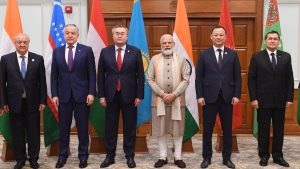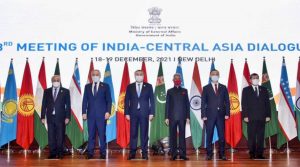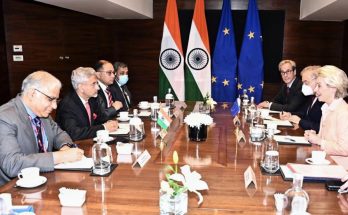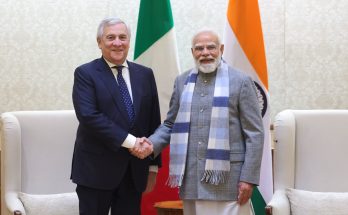By Amb (Retd.) Ashok Sajjanhar
India was in discussion with the five Central Asian States to invite their leaders jointly as Chief Guests to its Republic Day celebrations in 2022 to mark 30 years of establishment of diplomatic relations. This would have been similar to the visit of ten ASEAN leaders in 2018. However, the pandemic changed plans and now India will have its first virtual summit with these countries on January 27. This digital summit would provide a quantum jump to bilateral partnership, says Amb. (Retd) Ashok Sajjanhar in a big-picture article for India and The World magazine.
The five countries of Central Asia viz Kazakhstan, Kyrgyzstan, Tajikistan, Turkmenistan and Uzbekistan are celebrating the 30th anniversary of their independence from the Soviet Union in 1991. These five nations were the last to declare independence from the Soviet Union as they did not wish to sever their ties with Moscow.
The last thirty years have witnessed significant changes in all these countries. They have used this period in nation building and consolidation of their statehood. The pessimistic scenarios painted in the early nineties of Central Asia disintegrating have been jettisoned.
Growing Significance and Challenges

All the five countries are richly endowed with natural and mineral resources. Kazakhstan has huge commercially viable quantities of most minerals and elements in the Mendeleev’s Table, like coal, oil, gas, uranium, gold, iron ore and several more. Turkmenistan contains the world’s fourth largest reserves of natural gas while also having significant quantities of cotton, uranium, petroleum and sulfur. Uzbekistan is richly endowed with gas, uranium, cotton, silver and gold while both Tajikistan and Kyrgyzstan have abundant supplies of fresh water whose full potential is yet to be exploited. Kyrgyzstan has significant reserves of gold, uranium, mercury and lead also. The five countries have been able to exploit their resources to differing degrees.
All the five nations are land-locked. This was a compelling reason why these countries did not wish to break away from Moscow. They felt that they would not be able to survive as independent nations as they did not have access to the warm waters of the seas. Most of the five republics have been able to convert this liability into an asset by making their territories available for laying webs of ambitious infrastructure projects like highways, railways, roads as well as oil and gas pipelines, crisscrossing from East to West and North to South to connect industrial and production hubs with consumer markets. The last few years have seen highways and railroads traversing from the East in China through Kazakhstan and Uzbekistan to Europe, Russia, Iran and the Middle East. Most of these countries are partnering with China in its Belt and Road Initiative (BRI) to differing degrees. Kazakhstan, because of its 1,700 kms border with China, is the most active in BRI projects, while no BRI project has thus far been launched in Kyrgyzstan. Similarly, oil from Caspian Sea offshore facilities in Kazakhstan and gas from Turkmenistan are being shipped by pipelines to the western region of China through Uzbekistan and Kazakhstan.
All the five countries have, by and large, been peaceful and stable throughout the thirty years of their independent existence except for the civil war in Tajikistan in the early ’90s, the Andijan uprising in Uzbekistan in 2005, and the outbreak of sectarian clashes in the south of Kyrgyzstan in 2010. Although terrorist groups like Islamic Movement of Uzbekistan (IMU), Hizb-ut-Tahrir (HuT) and others are present in the Ferghana valley, they have not been very active or effective in creating disturbances. This could change if violence due to the Taliban take-over in Afghanistan increases and spreads to these countries.
The five republics have been largely secular and liberal so far. There have not been too many instances of religious militancy or extremist violence in any of the countries. There are strong apprehensions that this could change.
The presence of the Taliban dispensation in Afghanistan with which three Central Asian States share borders viz Tajikistan (1,300 kms), Uzbekistan (142 kms) and Turkmenistan (740 kms) is a matter of grave concern. The Taliban is a divided house with many factions violently opposed to each other. In addition, there are a number of terrorist groups like IMU, HuT, Ansarullah Jamaat, Al Qaeda, Islamic State-Khorasan Province etc in Afghanistan, all of which are keen to foment instability and violence in Central Asia. Traditionally, Central Asia has been an arena of ‘’great game’’. The modern version is being played out even today.
China Factor
Over the years, in addition to the BRI, trade and economic relations of these countries with China have grown rapidly. China has hugely expanded its footprint in the region and emerged as the most prominent trading and investment partner of these countries. Antipathy against China in most Central Asian countries has, however, grown in recent years because of its rapidly growing presence in their political and economic systems. The incarceration and persecution of several Kyrgyz and Kazakh Muslims along with Uyghur Muslims in the Xinjiang region has given rise to severe disaffection against China and resulted in many anti-Chinese protests in these countries.
Russia considers this region as its near-abroad and is determined to maintain its pre-eminence in these countries. Its role and presence as a security provider has grown because of the instability in Afghanistan. It is, however, feeling the pressure due to the expanding presence of China in these countries.
Although China has largely been deferential to Russia and is likely to remain so in the near term, there are signs that it is expanding its presence beyond the economic to the security and defence arena also. As China’s economic and security interests grow in the region, the current Sino-Russian framework of cooperation could be folded within a broader PaxSinica in which Beijing increasingly calls the shots. This would be a matter of huge concern for Russia.
Central Asia-India Connect
India has several millennia-old historical, cultural and civilizational links with Central Asia. Brisk trade of goods, ideas and thoughts took place from India (and China) to Central Asia and beyond, over the Silk Road from 3rd century BCE to 15th century CE. Buddhism travelled to Afghanistan, Central Asia and Western China from India through the Silk Road. India and Central Asia enjoyed vibrant economic and cultural ties when the latter was a part of the Soviet Union.
India has not been able to take full advantage of its close civilizational linkages with this region because it does not share a common land border with these countries. To overcome this obstacle, several initiatives, which have been in the pipeline for many years, have now been fast-tracked. Two of the most significant are the International North South Transport Corridor (INSTC) and the Chabahar port.
The strategic, political, security and economic significance of this region was underscored by Prime Minister Narendra Modi’s visit to these five republics in July, 2015. He became the only Indian Prime Minister to visit all these five states. He again travelled to Tashkent in 2016; Astana (now Nur-Sultan) in 2017; and Bishkek in 2019 for Summit Meetings of the Shanghai Cooperation Organization (SCO). He took advantage of these Summits to meet Presidents of the Central Asian Republics and take bilateral cooperation forward.
Central Asian Republics constitute the extended neighborhood of India. Collaboration between India and Central Asian countries, and others, is essential to bring peace and stability to Afghanistan. It is in the pursuit of this endeavor that India’s National Security Advisor invited the Secretaries of National Security Councils of the 5 five States as well as of Iran and Russia for the Delhi Regional Security Dialogue in New Delhi on 10th November, 2021. China and Pakistan were also invited but they declined to attend. The participating countries unanimously adopted the Delhi Declaration calling upon the Taliban to install an inclusive government in Afghanistan, respect the rights of minorities including the Tajiks, Uzbeks, Hazaras, Shias as well as of women and girls, and ensure that the Afghan territory is not used to launch terror attacks against other countries. The same message was reiterated at the Third India-Central Asia Dialogue (India-CAD) convened by India’s External Affairs Minister (EAM) with the Foreign Ministers of the five Central Asian countries in New Delhi on 19th-20th December, 2021.
Immense potential exists to deepen cooperation between India and Central Asia in trade and investment, defence and security, energy, information and communications technology, pharmaceuticals, capacity building, agriculture, innovation, education, culture, tourism, space, mining, joint ventures etc. Private businesses, small and medium enterprises and start-ups need to actively contribute in this endeavour.
The Way Forward

At the second India-CAD held virtually in October, 2020, India offered a $1 billion Line of Credit for priority developmental projects in fields such as connectivity, energy, IT, healthcare, education, and agriculture. All these are niche areas in which India has proven expertise and capabilities. Central Asian countries “welcomed India’s offer to provide grant assistance for implementation of High Impact Community Development Projects (HICDP) for furthering socio-economic development in the countries of the region.”
India is also taking vigorous action to modernize and upgrade the facilities at Chabahar port to improve connectivity between India and Afghanistan and Central Asia.
At the Third India-CAD, the Ministers committed themselves to achieve the full potential of trade, especially in sectors like pharmaceuticals, information technology, agriculture, energy, textiles and gems and jewelry. They also focused on establishing direct linkages between the states of India and regions of Central Asian countries, including through establishment of twinning/partnership relations. The ministers encouraged the India-Central Asia Business Council (ICABC), established early last year, “to promote business linkages and incentivise mutual investments.’’ Several areas like health-care, including medical tourism; pilgrimage, historical and cultural tourism; encouraging investment in tourism infrastructure were identified for focused attention.
It was decided to strengthen collaboration in defence and security, and hold regular consultations among the National Security Councils to fight against terrorism and other emerging challenges in the region.
India was in discussion with the five Central Asian States to invite their Presidents jointly as Chief Guests to its Republic Day celebrations in 2022 to mark 30 years of establishment of diplomatic relations. This would have been similar to the visit of ten ASEAN leaders in 2018. However, the pandemic changed plans and now India will have its first virtual summit with these countries on January 27. This digital summit would provide a quantum jump to bilateral partnership.
India enjoys huge goodwill in Central Asia. It is proactively engaging the leadership and people of these countries to realize the full potential of the partnership.
(Amb. Ashok Sajjanhar, former Ambassador of India to Kazakhstan, Sweden and Latvia, is Executive Council Member, Manohar Parrikar Institute for Defence Studies and Analyses)
Author Profile
- India Writes Network (www.indiawrites.org) is an emerging think tank and a media-publishing company focused on international affairs & the India Story. Centre for Global India Insights is the research arm of India Writes Network. To subscribe to India and the World, write to editor@indiawrites.org. A venture of TGII Media Private Limited, a leading media, publishing and consultancy company, IWN has carved a niche for balanced and exhaustive reporting and analysis of international affairs. Eminent personalities, politicians, diplomats, authors, strategy gurus and news-makers have contributed to India Writes Network, as also “India and the World,” a magazine focused on global affairs.
Latest entries
 DiplomacyJanuary 5, 2026India walks diplomatic tightrope over US operation in Venezuela
DiplomacyJanuary 5, 2026India walks diplomatic tightrope over US operation in Venezuela India and the WorldNovember 26, 2025G20@20: Africa’s Moment – The Once and Future World Order
India and the WorldNovember 26, 2025G20@20: Africa’s Moment – The Once and Future World Order DiplomacyOctober 4, 2025UNGA Resolution 2758 Must Not Be Distorted, One-China Principle Brooks No Challenge
DiplomacyOctober 4, 2025UNGA Resolution 2758 Must Not Be Distorted, One-China Principle Brooks No Challenge India and the WorldJuly 26, 2025MPs, diplomats laud Operation Sindoor, call for national unity to combat Pakistan-sponsored terror
India and the WorldJuly 26, 2025MPs, diplomats laud Operation Sindoor, call for national unity to combat Pakistan-sponsored terror







